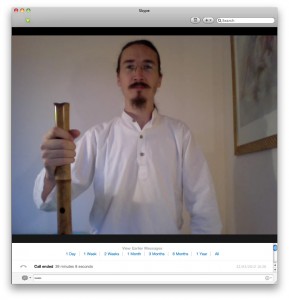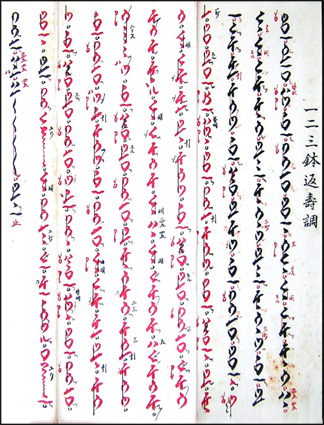Lessons are usually one hour long, once per week, and are available in person in London, England, and online via skype, a free video chat technology. With the difficulty of traveling long distances or for those overseas, online lessons give the opportunity of learning from your own home. Although studying in person is preferable, online lessons are in fact particularly well suited to studying shakuhachi, so if you are unable to come for lessons in person, this is a highly recommended way of studying.
Skype lessons
All you will need for skype lessons is a computer with an internet connection, the free skype software which you can download from www.skype.com and a web camera and microphone. Many computers have built in webcams and mics, but if not, they are easy and inexpensive to purchase separately. For any questions about setting up, please contact Justin and he will be happy to help.
“Justin is a balanced teacher with extensive knowledge, patience, awareness, and skill. With Justin as a teacher I know that should I want to learn about most anything he will be able and willing to teach me. Justin, to our benefit, has seemingly “left no stone unturned” and continues to research and dig deeper into matters. From shakuhachi history, antique shakuhachi, body mechanics, performing, preserving unique styles, spirituality or meditation, and jiari and jinashi shakuhachi construction – Justin provides a complete shakuhachi learning experience. I came to Justin to learn honkyoku pieces and styles which are rare in Japan and previously unavailable to the rest of the world, however, I have since learned much more than just pieces of music. I had seven years of previous shakuhachi experience before coming to Justin which includes three years of full-time study in the Jin Nyodo style, however, learning under Justin’s skilful guidance has enabled me to build what I feel is a truly solid foundation from which I look forward to many more learning experiences.” Skype student for 7 months, U.S.A.
“I’ve received lessons from Justin Senryu for 2 years already, both in person and internet. His detailed technique indications have been very useful to improve my overall playing. Besides, he is teaching some old styles, very difficult to find elsewhere, like Shimpo Ryu and Seien Ryu.
I recommend him to everybody, at any level of playing.” Student for 2 years, Spain.
Study Program
During your lessons you will be guided through the basic skills of posture and sound production, and step by step through any of the following repertoires:
Honkyoku: the original solo music of shakuhachi, from the Komusō of Fuke-shū. See Justin’s repertoire here.
Sankyoku: ensemble music with shakuhachi, koto and shamisen.
Shinkyoku: early 20th century compositions for both solo shakuhachi and shakuhachi with a variety of Japanese and non-Japanese instruments, by composers such as Miyagi Michio and Fukuda Randō.
Gendaikyoku: contemporary compositions for both solo shakuhachi and shakuhachi with a variety of Japanese and non-Japanese instruments.
Honkyoku
Regional styles:
Kinko-ryū
Seien-ryū
Myōan Shimpō-ryū
Kimpū-ryū (aka. Nezasa-ha)
Ōshū-kei
Kyūshū-kei
For those wishing to study honkyoku, new students will first study Seien-ryū, the oldest form of the honkyoku of Fudaiji temple. This straightforward style has relatively little ornamentation and embodies a clean and fresh Zen aesthetic, and gives wonderful repertoire of 11 honkyoku. With a firm base in this style, the student may go on to study any of the other regional honkyoku styles. As well as the 6 regional styles listed above, Justin also teaches the more individualistic styles of Higuchi Taizan (Taizan-ryū), Watazumi (Chikushinkai/Dōkyoku) and Jin Nyodō.
Advanced students are also welcome. Justin continues to help a number of teachers around the world in expanding their repertoires with the diverse regional styles he teaches, each with unique tones, nuances and techniques.
Notation
Notation will be provided. There are a variety of regional and historical notation styles for shakuhachi, all of which are in a simple form of Japanese alphabet. This notation is beautiful and surprisingly easy to learn. It differs to Western music notation in that it shows not only the pitch but the tone colour, and the timing for many of the pieces is written in an intuitive style perfectly suited to the ‘free rhythm’ of honkyoku. Each regional honkyoku repertoire is complete in itself and takes much time and dedication to master. Most students would not study Justin’s entire honkyoku repertoire (over 100 pieces) but rather focus on one or two regional styles, so reading will be straightforward.
For those with special interest, Justin teaches the ancient repertoires each in their original variety of notation styles as they were taught to him. Myōan Shimpō-ryū is the rarest of these. During the Edo period this was the music played at the famous Myōan temple, the main temple of the Kansai area. While some of the pieces of this repertoire have been reconstructed in recent times and re-written in modern notation forms, the teaching of the original music using the ancient Myōan notation is being passed down by only Justin and his teacher in Nagasaki. Playing from this notation is particularly rewarding, giving a tangible link to the ancient komusō tradition of Kyōto.
For more on the various forms of shakuhachi notation which Justin teaches, please click here.
Cancellation Policy
In Japan the usual system of paying for lessons is by paying a fixed fee at the beginning of each month. In that case even if the student misses all of their lessons, no money is refunded. And you can still be made to pay for the lessons you do not attend even if you give advanced notice that you will be away for several weeks. Justin feels this can be a little harsh on the students, but that having no cancellation system would similarly be too harsh on the teacher, since the teacher makes the commitment to reserve the time for the student’s lesson. Therefore he asks that students give at least one week’s notice for cancelling any lesson, and that unless such notice is given, they pay for any lessons missed.
History
Justin is a life-time member of Komusō Kenkyū Kai, the main research organisation for ancient shakuhachi music in Japan. He has traveled extensively around Japan conducting research and study of not only each regional style of honkyoku playing, but also of antique instruments and notation. His particular speciality of research concerns how honkyoku pieces change over time within individual lineages, and how they change as they pass from one lineage to another. For those students interested in the historical context of the music, Justin’s lessons will include the background stories and histories of the pieces and repertoires he teaches.
Contact Justin for more details.



